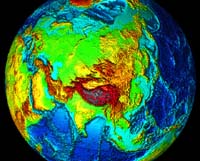
(from http://www.ngdc.noaa.gov/)
Rapid crustal thickening during continental collisions produces high temperatures because of the large amount of radiogenic elements in continental crust. The pressures are moderate because continental crust is never thicker than ~75 km (2.5 GPa). These abnormally high temperatures are followed by cooling to a normal cratonal geotherm. This is the cause of so-called "Barrovian" metamorphism, signature minerals of which are staurolite + kyanite. Good examples are known from the Tibet and Himalaya.

(from http://www.ngdc.noaa.gov/)
The geological history of India-Asia is a sequence of continental collisions in the Triassic, Late Cretaceous and Tertiary (~50 Ma to Recent):
The India-Asia collision zone is our best example of an active continent-continent collision:
A geological map of the central Himalaya shows the crystalline rocks of the Indian crust (Subhimalayan sequence), passive margin sediments of the Indian plate (Lesser Himalayan sequence), crystalline rocks of the Tibetan crust (High Himalayan Crystallines), passive margin sediments of the Tibetan crust (Tethyan Himalaya), and pre-collisional Gangdise Batholith:
Deep-level constraints on the present-day structure of the orogen are provided chiefly through seismic reflection and refraction data:
A geological cross section across the entire Tibetan Plateau shows that the southern margin of the Plateau is underlain by India and the northern margin of the Plateau is underlain by Asia.
The present-day high (5 km) elevation of the plateau is believed to be related to large-scale crustal thickening, combined with delamination of the mantle lithosphere and asthenosphere reaching to unusually shallow levels:
The thermal evolution during continental thickening can be modeled with a 1-D "sawtooth" thermal gradient, and attains high temperatures largely through the extreme thickness of radiogenic material.
Continental thickening can lead to interesting kinds of melts and residuum that subsequently influence the deformation and evolution of the orogen:
An example of the texture produced by such melting is given here:
and here:
One example of typical Barrovian continental metamorphism is Kangmar Dome in southern Tibet:
The calculated P-T conditions/paths of various samples indicate a large range of pressures from ~3 to 8 kbar, but a modest range in temperature from ~400 to 600°C.
This group of P-T paths can be explained as part of what one would expect from the kind of burial and heating characteristic of Barrovian metamorphism.
Here are the calculated P-T conditions of samples shown in the cross section.
The P-T conditions of the samples constrains a surprisingly complicated tectonic history.
Small pieces of continental material subducted to as much as 200 km are eventually regurgitated, leading to ultrahigh P/T metamorphism. These rocks contain extremely unusual crustal minerals, such as coesite, diamond, and majorite. Some of the most famous sites include the Dabie Shan of China, western Norway, and the Dora Maira Massif of the Italian Alps.
These unusual rocks are now known from many localities around the world:
Coesite is the most common indicator of ultrahigh-pressure metamorphism:
Coesite converts partially or completely to quartz during exhumation:
Rarer diamonds are also known from UHP rocks:
The Chinese are drilling a 5-km deep drillhole through UHP rocks in eastern China:
Some of the key mineral equilibria that govern the identification of UHP rocks are shown here:
The pressures of UHP terranes are as high as 6 GPa, indicating subduction to depths of 200 km. Most terranes have temperatures of <800°C, but some are as hot as 1200°C:
One of the best-known UHP belts is the Dabie-Sulu belt of eastern China:
High- and ultrahigh-pressure rocks crop out in a wedge shape overlain by a supra-lithospheric scale extensional fault:
A modern analog for UHPM is the Hindu Kush mountain range of central Asia:
which shows earthquakes down to depths of xxx km in material that has seismic wave speeds consistent with continental crust.
Seen here in cross section:
The northeastern margin of Australia is also subducting to UHP depths beneath the Banda arc, seen here in map view:
and cross section:
Thermal models show that subduction of a continental margin leads to subduction-zone like cold temperatures at high pressures.
These subducted continental rocks are exhumed through the mantle following tearing of the slab (called "slab breakoff")
In China, the wedge shape of the HP-UHP rocks, the structural geology, and geochronology imply that the subducted continental margin had a shape like a wedge or Florida: